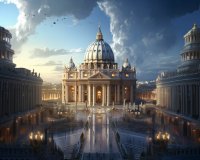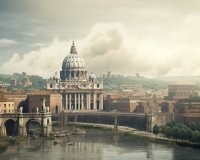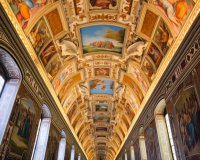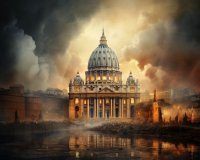Michelangelo’s Masterpiece: Exploring the Wonders of the Sistine Chapel
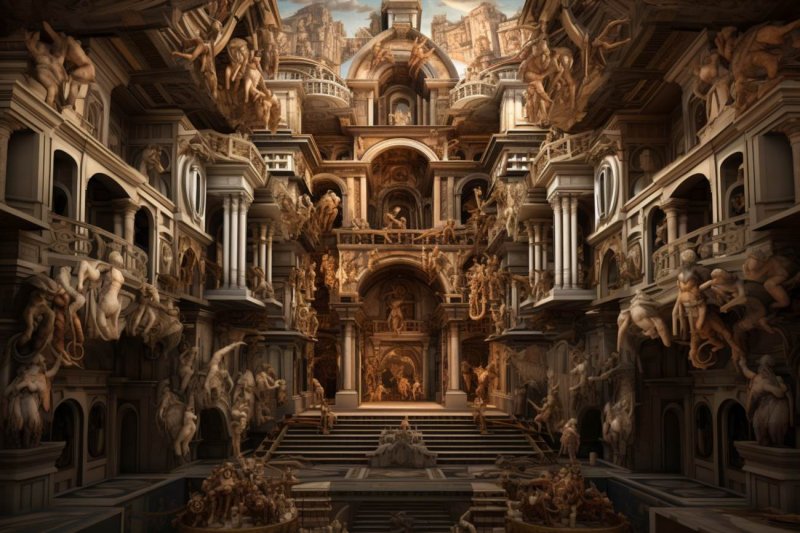
Michelangelo's Masterpiece: A Deep Dive into the Sistine Chapel
The Sistine Chapel, located within the Vatican City, is one of the most renowned and celebrated artistic and religious sites in the world. At its heart lies a treasure trove of divine art, with Michelangelo's frescoes taking center stage as the crowning jewel. In this deep dive, we will explore the historical significance, architectural marvel, and the mesmerizing artistry that encapsulates the Sistine Chapel.
The Sistine Chapel's Historical Significance
The Sistine Chapel, consecrated in 1483, holds immense historical and religious significance. Named after Pope Sixtus IV, it was originally built as a place of worship and reflection for the Vatican's clergy. Over the centuries, it has witnessed countless important events, including papal elections and conclaves that have chosen new popes. The chapel is a living testament to the enduring power of the Catholic Church.
However, the Sistine Chapel's true claim to fame rests in its ceiling, adorned with the timeless masterpieces by the Italian Renaissance artist, Michelangelo Buonarroti.
Michelangelo's Artistry
Michelangelo was commissioned by Pope Julius II to decorate the Sistine Chapel's ceiling. The artist embarked on this monumental task in 1508, and the project lasted four years, concluding in 1512. The result is a breathtaking array of frescoes that have left an indelible mark on the history of art and continue to captivate viewers from around the world.
The most iconic of these frescoes is the "Creation of Adam." This masterpiece, positioned at the center of the ceiling, portrays the biblical story of God giving life to Adam with a touch of His finger. The detail and emotional depth in this artwork are unparalleled, with every muscle and bone expertly rendered by Michelangelo's hand.
Another notable fresco is the "Last Judgment" located on the altar wall. Painted later in Michelangelo's life, it depicts the Second Coming of Christ and the final judgment of souls. The sheer size and complexity of this composition is awe-inspiring, as it spans the entire altar wall.
Architectural Marvel of the Sistine Chapel
Beyond the artistic wonders, the Sistine Chapel itself is an architectural marvel. Its dimensions are intentionally designed to create an acoustic environment conducive to liturgical music. The chapel's rectangular shape, high ceiling, and walls adorned with intricate art enhance the sound, making it a prime location for choral performances.
The Chapel also features a remarkable series of tapestries designed by Raphael, which adorn the lower walls. These tapestries add to the chapel's grandeur and are part of the overall visual experience for visitors.
Preservation and Conservation
Preserving the Sistine Chapel's art is a continuous and delicate endeavor. The frescoes are highly susceptible to damage from factors like humidity, dust, and even the breath of the visitors. To protect the masterpieces, stringent conservation measures, including a strict no-photography policy, are in place.
Visiting the Sistine Chapel
The Sistine Chapel is open to the public, and countless visitors from all corners of the globe come to admire its beauty each year. It's an experience that transcends words, a journey through history and the divine, an encounter with Michelangelo's genius.
If you plan to visit the Sistine Chapel, make sure to dress modestly, as it is a sacred space. You'll enter through the Vatican Museums, and once inside, take your time to savor the remarkable artistry and history that fills every corner.
Conclusion
The Sistine Chapel stands as a testament to human creativity, faith, and the enduring power of art. Michelangelo's masterpieces within this sacred space are a source of inspiration for artists, historians, and all those who appreciate the profound beauty that can be achieved through artistic expression.
Visiting the Sistine Chapel is not just a journey through the annals of history but a transcendent experience, a communion with the divine through the eyes and hands of one of the greatest artists the world has ever known.
Vatican City: Saint Peter's Basilica Digital Audioguide
Discover the fascinating history and awe-inspiring beauty of St. Peter's Basilica with a 60-minute audio-guided tour on your smartphone. Immerse yourself in the grandeur of one of the most renowned landmarks in Rome, and delve into its rich past and magnificent architecture.
St. Peter's Basilica, located in Vatican City, stands as a testament to centuries of religious significance and architectural brilliance. Originally commissioned in the 16th century by Pope Julius II, this majestic Basilica was built upon the site believed to be the burial place of Saint Peter, one of the twelve apostles of Jesus Christ.
Embark on a captivating journey as you explore the legends and myths surrounding St. Peter's Basilica. Learn about the construction of its towering dome, a marvel of Renaissance engineering, and marvel at the oculus that bathes the interior in celestial light. Discover the renowned tombs housed within the basilica, the final resting places of numerous popes and other notable figures.
Through 27 listening points and a convenient digital map, the audio tour will guide you through the basilica's most significant features. Uncover the intricate details of the basilica's interior, from its ornate decorations to the intricate mosaic artwork adorning its walls. Gain insight into the symbolism and historical context behind the remarkable pavement beneath your feet.
Whether you are an art enthusiast, a history buff, or a spiritual seeker, this audio-guided tour of St. Peter's Basilica offers a comprehensive and engaging experience. Immerse yourself in the grandeur and majesty of this iconic masterpiece, and deepen your understanding of its profound cultural and religious significance.
Highlights
Unravel the history of the St. Peter's Basilica on with a mobile audio guide. Learn about the treasures inside St. Peter's Basilica at your own pace. Download an audio guide on your smartphone to enjoy maximum flexibility. See St. Peter’s tomb and the original basilica walls while learning about them. Immerse yourself in a journey through art and religion at an iconic landmark.
Meeting Point
You can go directly to St. Peter's Basilica whenever you want, there is no meeting point. At the time of booking, you will receive a QR code to download the audio guide track. This will allow you to go to the Basilica when and how you want without having to follow fixed times and appointments.
Important Information
What to Bring: Headphones, Charged Smartphone
Not Allowed: Shorts, Weapons or sharp objects, Luggage or large bags, Short skirts, Sleeveless shirts
All visitors must pass through airport-style security. During high season the wait at security may be up to 120 minutes
This is a digital experience. Once you book, you'll immediately be sent a link to download the app and content. Make sure you download the audio guide on your device before your visit. There is no meeting point or staff on-site.
St. Peter’s Basilica and the Square may be closed in the morning due to Papal Audience (usually on Wednesdays and Sundays)
The opening hours are subject to change due to special events at the Vatican Museums, Sistine Chapel, and St. Peter's Basilica. Usually, the St. Peter's Basilica is open from 8.00 to 18.00.
The entrance to the Basilica is free of charge and doesn't require an entrance ticket.
You must observe the dress code to access the St. Peter’s Basilica (no shorts, vests, or sleeveless tops)
Price: From $6.30 per person
Reserve now & pay later to book your spot and pay nothing today
The Creation of the Sistine Chapel: A Masterpiece of Art and Faith
The Sistine Chapel, located within Vatican City, is one of the most iconic and revered artistic treasures in the world. Its creation is a testament to the intersection of art, religion, and human creativity. In this article, we will delve into the history, significance, and the awe-inspiring artistry that adorns the ceiling of the Sistine Chapel.
History and Construction
The construction of the Sistine Chapel began in 1473 under the patronage of Pope Sixtus IV, for whom it was named. The chapel was designed by the renowned architect Giovanni dei Dolci, and its architecture reflects the Renaissance style, characterized by harmony, symmetry, and a focus on classical forms.
The construction of the chapel was completed in 1481, and it was consecrated on August 15, 1483. It has since been used for various religious ceremonies, including papal conclaves, which are gatherings of cardinals to elect a new pope.
The Ceiling: Michelangelo's Magnum Opus
When one thinks of the Sistine Chapel, the first image that comes to mind is often the breathtaking ceiling, which is a masterpiece created by the Italian artist Michelangelo. In 1508, Pope Julius II commissioned Michelangelo to paint the ceiling, which was a monumental task.
Michelangelo's work on the ceiling spanned from 1508 to 1512, and the result is nothing short of extraordinary. The entire ceiling is a canvas filled with a series of intricate frescoes that depict various scenes from the Bible, including the Creation of Adam, the Creation of Eve, and the Great Flood. Michelangelo's use of color, perspective, and composition is a testament to his genius as an artist.
The Creation of Adam: A Pinnacle of Artistic Achievement
One of the most famous and iconic images from the Sistine Chapel ceiling is "The Creation of Adam." This fresco, located at the center of the ceiling, portrays the Biblical moment when God gives life to Adam through a gentle touch of their fingertips.
The composition of this masterpiece is striking. God and Adam are both depicted in a state of divine grace and physical perfection. The outstretched fingers of God and Adam nearly touching symbolize the transmission of life and knowledge from the divine to humanity. This image has become a symbol of human potential and the connection between the divine and the earthly.
Restoration and Preservation
Over the centuries, the Sistine Chapel has undergone several restorations to preserve its artistic treasures. One of the most significant restorations occurred in the late 20th century, lasting from 1980 to 1994. During this painstaking process, layers of dirt and grime that had accumulated over the centuries were carefully removed, revealing the true brilliance of Michelangelo's work.
Today, the Sistine Chapel continues to be a place of pilgrimage for art lovers and the faithful alike. It serves as a testament to the enduring power of art and faith to inspire and uplift the human spirit.
Conclusion
The Sistine Chapel stands as a living testament to the power of art and faith to transcend time and space. Michelangelo's breathtaking ceiling frescoes, especially "The Creation of Adam," continue to captivate and inspire people from all walks of life. As a place of both religious worship and artistic appreciation, the Sistine Chapel remains a symbol of the profound connection between humanity and the divine.
Rome: Vatican City Highlights Tour with Skip-the-Line Entry
Embark on a journey through the cultural treasures of Vatican City with a guided tour that grants you skip-the-line access to its iconic landmarks. Delve into the Vatican Museums, Sistine Chapel, and St. Peter's Basilica, bypassing the queues for an immersive Vatican City experience.
About this activity
Gain insights into the artistic wonders of the Vatican as you explore the Vatican Museums with a knowledgeable guide. Marvel at masterpieces from Ancient Greece and the Renaissance, from the massive bronze statue in the Pinecone Courtyard to the historic maps in the Gallery of Maps.
Learn about different artistic techniques and the fascinating rivalries between artists as you traverse the Vatican City. Admire mosaics, golden ceilings, and memorable statues within the grandeur of St. Peter's Basilica.
Experience Highlights
- Skip the long lines to the main monuments of the Vatican City
- Explore the Vatican Museums with your tour guide
- Discover artistic techniques and the rivalry between artists
- Marvel at Michelangelo's miraculous ceiling in the Sistine Chapel
- Witness the grandeur of St. Peter’s Basilica
Save valuable time in Rome with this tour that seamlessly integrates skip-the-line access to the Vatican Museums, Sistine Chapel, and St. Peter's Basilica.
Includes
- Skip-the-line entrance to the Vatican Museums and Sistine Chapel
- Skip-the-line entrance to St. Peter's Basilica
- All entrance and reservation fees
- Professional guide with headsets
- Free Wi-Fi at the meeting point
- Hotel pick-up and drop off
- Optional gratuities
- Access to the dome at St. Peter's Basilica
Join a small group, limited to 10 participants, and immerse yourself in the rich history and artistry of Vatican City.
Meeting point
Meet your guide directly in the office at Via Santamaura 14B. Open in Google Maps.
Important information
- Comfortable shoes are strongly recommended due to the walking involved
- Visitors must cover their knees and shoulders to enter the Vatican Museums and St. Peter's Basilica
- Restrictions on bag size and prohibited items in the Vatican Museums
- St. Peter’s Basilica may have unforeseen closures for spiritual celebrations
Immerse yourself in the art, history, and spirituality of Vatican City with this meticulously crafted tour.
Customer reviews
Overall rating: 4.8/5 based on 498 reviews
Review summary:
- Guide: 4.8/5
- Value for money: 4.6/5
- Service: 4.5/5
- Organization: 4.5/5
Read what travelers are saying about their experience exploring the Vatican City highlights.
Detailed Overview of Michelangelo's Frescoes in the Vatican
Michelangelo Buonarroti, one of the most celebrated artists of the Italian Renaissance, left an indelible mark on the world of art with his magnificent frescoes in the Vatican. These masterpieces, located in the Sistine Chapel, are a testament to Michelangelo's exceptional skill, creativity, and dedication to his craft.
The Sistine Chapel: A Storied Venue
The Sistine Chapel, situated within the Vatican City, is not only a place of religious significance but also an architectural marvel. It was designed by Giovannino de Dolci in the late 15th century, showcasing a harmonious blend of Renaissance and Gothic styles. The chapel's grandeur and solemnity provide an ideal backdrop for Michelangelo's breathtaking frescoes.
The Genesis of the Frescoes
Commissioned by Pope Julius II, Michelangelo began work on the frescoes in 1508. The initial commission was for the ceiling, a project that would consume four years of the artist's life. The resulting masterpiece is a celestial tableau depicting various scenes from the Book of Genesis, including the creation of Adam and Eve, and the Great Flood.
The Last Judgment: A Pinnacle of Artistic Achievement
After completing the ceiling, Michelangelo was once again summoned to the Sistine Chapel, this time by Pope Paul III, to adorn the altar wall with another masterpiece - The Last Judgment. This monumental fresco, completed in 1541, portrays the Second Coming of Christ and the ultimate judgment of souls. The level of detail and emotional intensity in this work is nothing short of awe-inspiring.
Techniques and Innovations
Michelangelo's frescoes are a testament to his technical prowess. He employed the fresco technique, which involves applying pigments to wet plaster, allowing for a seamless integration of colors with the surface. This method required meticulous planning and precision, as there was no room for error once the plaster dried.
Furthermore, Michelangelo's ability to depict human anatomy with unparalleled accuracy is evident in every figure he painted. The muscularity and dynamism of his characters breathe life into the scenes, creating a vivid and engaging narrative.
The Influence and Legacy
Michelangelo's frescoes in the Vatican have had a profound impact on the world of art and continue to be a source of inspiration for artists and admirers alike. The techniques he pioneered and the emotional depth he achieved set a standard that remains unrivaled to this day.
In conclusion, Michelangelo's frescoes in the Vatican represent a pinnacle of artistic achievement, showcasing the extraordinary talent and vision of a true master. These works continue to captivate and inspire audiences from around the globe, reaffirming Michelangelo's enduring legacy in the annals of art history.



